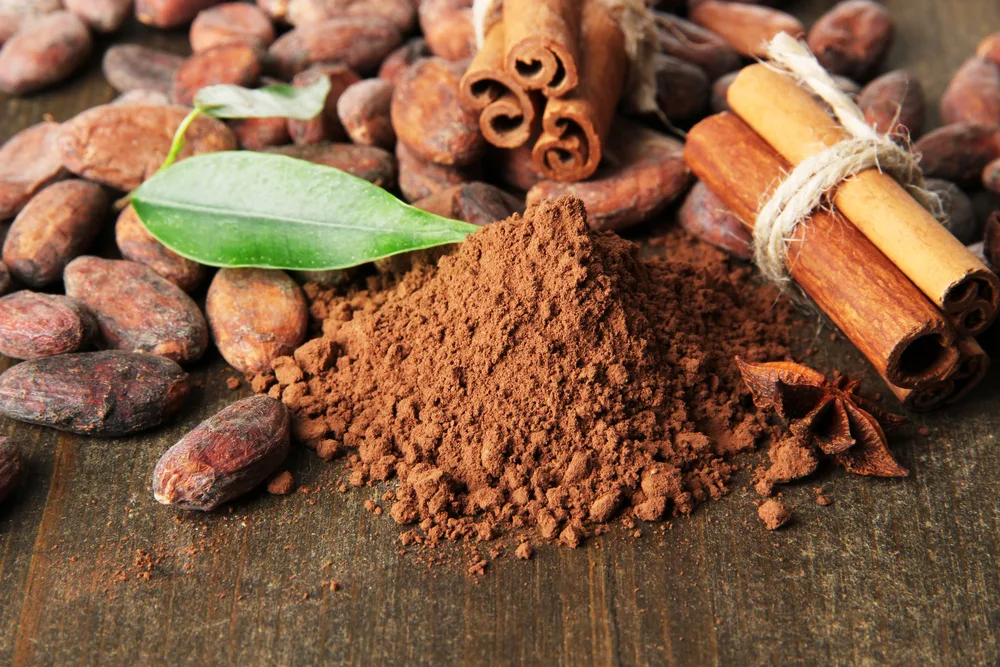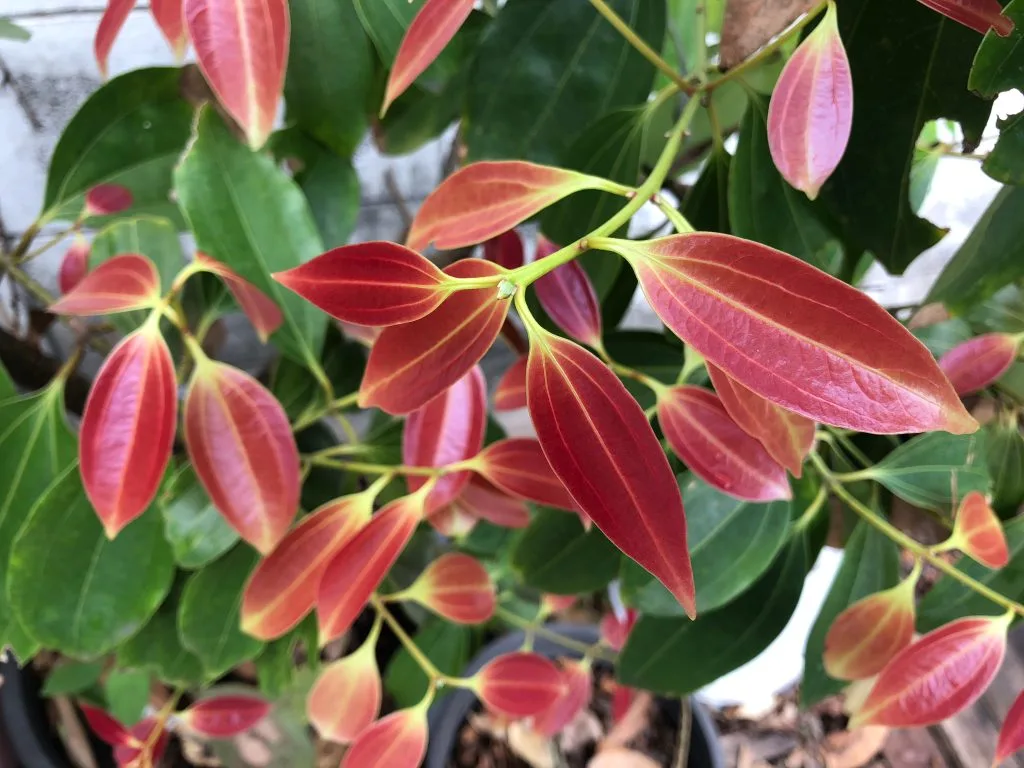If you’ve ever held a cinnamon stick, you’ve seen the dried bark of a cinnamon plant (Cinnamomum spp.).
Cinnamon plants have shiny leaves and small flowers. The bark and leaves have a nice smell because of oils. The inner bark of various species is used to create cinnamon spice.

Cinnamon species usually grow at a moderate pace and can be planted in the spring or early fall. If you live in a warmer area, with plenty of sunlight and good soil, it’s pretty easy to grow and collect your own cinnamon.
- Common Names: Cinnamon, cassia
- Botanical Names: Cinnamomum spp.
- Family: Lauraceae
- Plant Type: Tree, shrub
- Mature Size: 3 to 60 ft. tall, 2 to 20 ft. wide (depends on variety)
- Sun Exposure: Full, partial
- Soil Type: Loamy, well-drained
- Soil pH: Acidic to neutral (6.2–7.2)
- Bloom Time: Summer
- Flower Color: White, yellow
- Hardiness Zones: 10–12 (USDA) Native Area: Asia
Cinnamon Plant Care
Cinnamon is a tropical plant, so if you live in a warm area, USDA hardiness zones 10 through 12, you can plant cinnamon outdoors. Most people start with young nursery plants rather than seeds.
Here are the main care needs:
- Pick a spot that gives enough space for the plant to grow fully.
- Plant where it gets plenty of sunlight and isn’t blocked by larger trees and shrubs.
- Use good soil mixed with compost.
- Water deeply, making sure the soil doesn’t dry out completely.
- Fertilize regularly as the plant grows, then every Spring.
Light
Full sun, which means at least six to eight hours of direct sunlight most days, is best for cinnamon plants. But they’ll benefit from some shade in very hot and dry weather.
Soil
Cinnamon plants like rich, well-draining soil. A sandy loam works well. They don’t like waterlogged soil, so heavy clay or hardpan soil won’t work. If your garden soil isn’t right for cinnamon, grow it in containers with the right type of soil.
Water
These plants like regular rainfall like they get in the tropics, so you should water them if it doesn’t rain enough. Don’t let the soil dry out completely. Water when the top two inches of soil are dry, and use mulch to keep the roots cool and the soil moist.
Temperature and Humidity
Cinnamon plants love warm, humid weather. In their natural home, temperatures around 80°F help them grow well. They don’t like it below 40°F or very dry conditions.
If you live in a cold area north of where the plant grows naturally, you can grow cinnamon in containers in a greenhouse or keep the container outside in summer and inside in winter.
Fertilizer
Use a balanced, slow-release fertilizer when you plant your cinnamon. Then, fertilize every spring as directed.
Types of Cinnamon Plant

There are many kinds of cinnamon including:
- Cinnamomum verum: This is true cinnamon or Ceylon cinnamon, known for its great flavor.
- Cinnamomum cassia: Also called Chinese cassia, it’s the most common type of cinnamon in North America.
- Cinnamomum loureirii: Known as Saigon cinnamon or Vietnamese cinnamon, this kind has a strong flavor and aroma and costs more.
Pruning
Cinnamon plants don’t need regular pruning. But cut off any dead, damaged, or diseased branches to keep the plant healthy.
Harvesting
You can harvest cinnamon two to three years after planting, then every two years. Cut off branches or cut the whole tree at the trunk. (Trees in the ground often grow new shoots that become new trees.) Scrape off the outer bark until you see the yellowish-orange layer underneath, which is what you eat. Peel off strips of this cinnamon layer with a sharp knife or paint scraper, stopping when you see the lighter core.
Let the pieces dry indoors in a single layer for about a week. They’ll curl into cinnamon sticks. Then you can grind them or leave them as sticks. Keep your cinnamon in a sealed container in a cool, dry place, and it’ll stay good for a couple of years.
Propagating Cinnamon Plant
You can make new cinnamon plants from stem cuttings in spring or early fall.
- Take a cutting about six inches long, and remove the lower leaves.
- Plant the cutting in moist potting mix, and keep it warm, preferably on a sunny windowsill.
- Watch for roots, which might take several months.
- Plant outdoors in a hole big enough for the roots and fill with soil.
How to Grow Cinnamon Plant From Seed
Birds like the fruit of cinnamon plants. But if you can save some seeds, you can start new plants from them.
- Clean the seeds and let them dry.
- Plant fresh seeds as they lose their ability to grow quickly.
- Plant about an inch deep in pots with sterile seed-starting mix.
- Keep them warm and moist at around 75°F.
- Look for sprouts in about three weeks.
- Transplant when they’re established.
Potting and Repotting Cinnamon Plants
In colder areas, gardeners grow cinnamon in containers indoors or in a greenhouse in cold weather. Cinnamon plants don’t get as big in containers, but they still make cinnamon bark after a few years.
Start with a big container, at least 18 inches across and 20 inches deep, so the plant has room to grow.
The container should have drainage holes. Use loose, well-draining potting mix, and water when the top inch of soil dries out.
Put the plant outside in summer for more sunlight. Indoors, put it near a south-facing window. Spray the plant to raise humidity if needed. Fertilize in the growing season (spring to fall) with liquid fertilizer.
Overwintering
If you live where it’s cold, you can grow this plant in a greenhouse, indoors, or in a big container you can move inside when it’s cold. If you can’t move the plants, cover them when it’s below freezing.
Common Pests & Plant Diseases
Fungal diseases can hurt cinnamon plants in very wet or shady conditions. Insects like the cinnamon butterfly and cinnamon gall mite aren’t usually a problem outside the tropics. Leafminers and mealybugs can hurt cinnamon plants. Use organic insecticide if needed.
Common Problems with Cinnamon Plants
Cinnamon is easy to grow, but sometimes there are issues.
Yellow Leaves
If the leaves turn yellow and fall off, you might be watering too much. Pay attention to rain and adjust your watering.
Brown Spots on Leaves
Brown spots mean disease, like leaf spot. It can spread and eat away at leaves. Remove affected parts and use fungicide. Spray with neem oil often to stop it from coming back.
